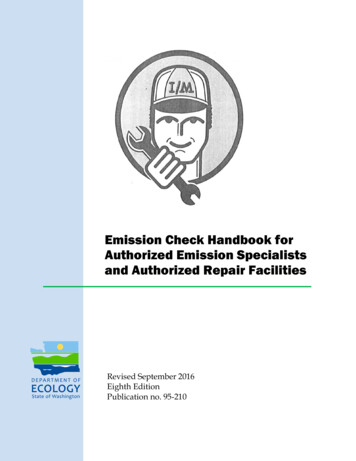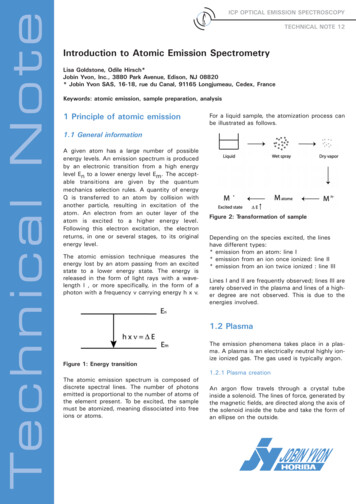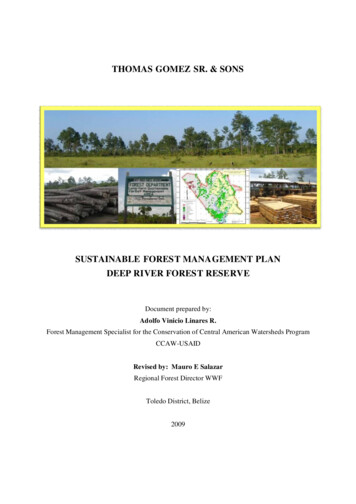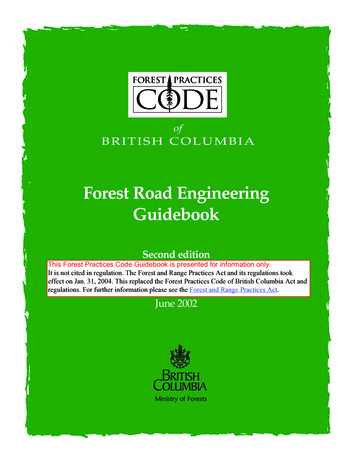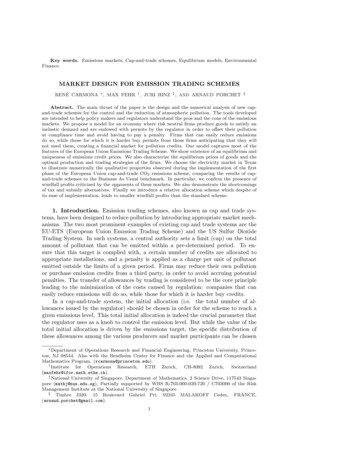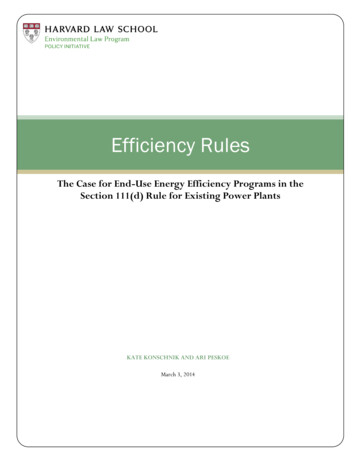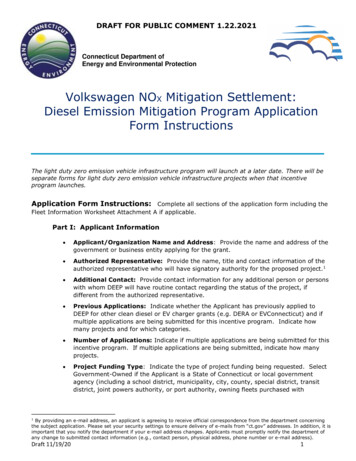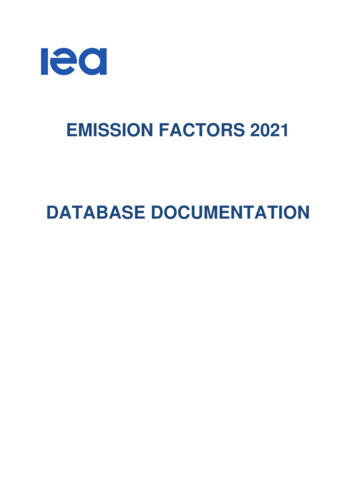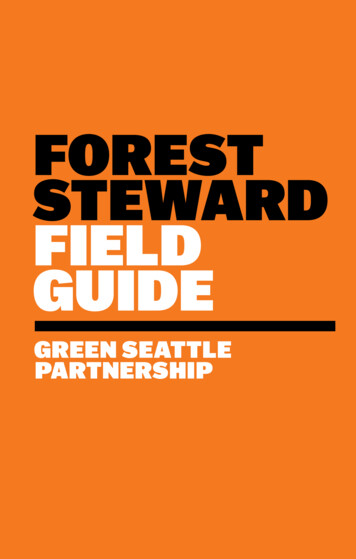
Transcription
Forest Reference EmissionLevel (FREL) of MyanmarMinistry of Natural Resources and Environmental ConservationMyanmarJanuary 2018
Table of ContentsList of Tables . iiiList of Figures . iiiList of Annex. iiiAcronyms . vSummary1.2.Introduction . 11.1.Objectives of FREL . 21.2.Summary of guidance considered for FREL development . 3National Context . 52.1.National circumstances . 52.2. Myanmar’s Nationally Determined Contributions-(NDC) submission and relation to the FREL . 63.2.3.Forests in Myanmar . 72.4.Forest Land Use and Land Cover by Forestry Legislation . 92.5.REDD development in Myanmar. 10Definitions . 113.1.Forest definition . 113.2.Deforestation definition. 123.3.Enhancement of forest carbon stocks through reforestation/afforestation activities . 124.Scale . 125.Scope (activities, pools, gases) . 135.1.REDD activities . 135.2.Pools and gases . 146.Reference period of FREL . 157.Data used in the FREL . 157.1.Activity data . 157.1.1.Rationale of sample-based approach: . 167.1.2.Sample design . 197.1.3.Response design. 217.1.4.Analysis design . 237.1.5.Estimation and uncertainty . 247.1.6.Results . 247.2.Emission factors . 277.2.1.Methodology for Emission Factor Calculation . 327.2.2.Results . 37
8.Myanmar FREL . 389.Uncertainty test . 3910. Future improvement opportunities . 4310.1. For Activity Data . 4310.2. For Emission Factors . 44References: . 46Annex . 49ii
List of TablesTable 2. 1: Area coverage of the major forest types and rainfall range . 8Table 2. 2. : Major Land Categories Reported to CSO . 10Table 7. 1: Validation datasets used to assess 1,884 samples . 22Table 7. 2: Structure of accuracy assessment matrix . 24Table 7. 3: Confusion matrix for 2005-2015 forest change map based on 1,884 stratified randomsamples . 25Table 7. 4: Bias-corrected area estimates in hectare (ha) with confidence intervals (CI), weightedproducer’s accuracy and user’s accuracy under forest and non-forest cover classes for the years 2005and 2015. . 26Table 7. 5: Bias-corrected area estimates in hectare (ha) with confidence intervals (CI), weightedproducer’s accuracy and user’s accuracy for three land cover classes during 2005-2015. . 26Table 7. 6: Sample Plot Design for 40 Districts used in Emission Factor Calculation . 29Table 7. 7: Per Ha Prorated Value for four different plot designs . 34Table 7. 8: AGB Value in CO2 eq ton per ha per plot design for each district . 34Table 7. 9: Description on the forest types and respective value of R (Ratio of BGB to AGB) and litterrange . 35Table 7. 10: Results of the CO2 eq Mean Value ton per ha and weighted mean CO2 eq ton per ha . 37Table 9. 1: Uncertainty Result for Activity Data in % . 40Table 9. 2.Uncertainty Result for Emission Factor in %.52List of FiguresFigure 7. 1: Steps followed to produce stratified random sample-based estimates of forest changeduring 2005-2015 in Myanmar. 18Figure 7. 2: Distribution of the 1,884 samples across Myanmar. . 19Figure 7. 3: Decision tree for sample change analysis . 21Figure 7. 4: Example of reference data (Google Earth Archive) . 23Figure 7. 5: Area estimates of forest cover change during 2005-2015, in million ha, from local landcover maps and from stratified random sampling design. . 27Figure 7. 6: Location of Inventory plots data collected during 2005 to 2017 . 32List of AnnexAnnex 1: Datasets used to generate activity data for establishing a forest reference emission level inMyanmar during 2005-2015 . 49Annex 2: Harmonizing national land use categories with FRA and IPCC land use categories . 50iii
Annex 3: Wall-to-wall thematic raster maps of Myanmar under seven national land use/covercategories at three years: 2005, 2010 and 2015. . 51Annex 4: A brief description of the simple and stratified random sampling estimators . 52Annex 5: Examples of sample assessment using validation datasets: . 55Annex 6: Plot Designs and Description . 58Annex 7: Summary of information of afforestation/reforestation during reference period of 20052015, as a benchmark for estimating GHG removals from the NRRPM (enhancement of forest carbonstocks) . 60iv
AcronymsADActivity DataAGBAbove Ground BiomassBGBBelow Ground BiomassBURBiennial Update ReportCH4MethaneCIConfidence IntervalCOCarbon MonoxideCO2 eqCarbon Dioxide EquivalentCSOCentral Statistical OrganizationDBHDiameter at Breast HeightECDEnvironmental Conservation Department, Ministry of Natural Resources andEnvironmental Conservation (MONREC)EFEmission FactorEIAEnvironmental Impact AssessmentFAOFood and Agriculture Organization of the United NationsFDForest Department, Ministry of Natural Resources and EnvironmentalConservation (MONREC)FRAForest Resource AssessmentFREL/ FRLForest Reference Emission Level/ Forest Reference LevelGDPGross Domestic ProductGFCGlobal Forest ChangeGFOIGlobal Forest Observations InitiativeGgGigagramGHGsGreen House GasesGISGeographic Information SystemGOFC-GOLDGlobal Observation of Forest and Land cover DynamicsGPGGood Practice GuidanceHahectareINDCIntended Nationally Determined ContributionIPCCIntergovernmental Panel on Climate ChangeIRSIndian Remote Sensing SatellitesLUKENatural Resources Institute FinlandLULUCFLand Use, Land Use Change and ForestryMCCSAPNational Climate Change Strategy and Action Planv
MGDMethods Guidance Documentmm/yearmillimeter per yearMOALIMinistry of Agriculture, Livestock and IrrigationMRVMeasuring, Reporting and VerificationN2ONitrous OxideNAPANational Adaptation Programme of ActionsNDCNationally Determined ContributionNFI/ NFMISNational Forest Inventory/ National Forest Monitoring Information SystemNFMSNational Forest Monitoring SystemNO2Nitrogen DioxideNRRPMNational Reforestation and Rehabilitation Programme in MyanmarPaMsPolicy and MeasuresPASProtected Area SystemPFEPermanent Forest Estate (RF PPF)PPFProtected Public ForestREDD Reducing Emissions from Deforestation and Forest Degradation, andConservation, Sustainable Management of Forest and Enhancement of ForestCarbon StocksRFReserved ForestRSRemote SensingSBSTASubsidiary Body for Scientific and Technological AdviceSEStandard Error of Sample MeanSEPALSystem for Earth Observation Data Access, Processing and Analysis for LandMonitoringSISSafeguard Information SystemSNCSecond National CommunicationSTRSStratified Random SampleTATechnical AssessmentTWGsTechnical Working Groups (Drivers and Strategy TWG, Stakeholder Engagementand Safeguard TWG and MRV TWG)UNFCCCUnited Nations Framework Convention on Climate ChangeUN-REDDUnited Nations Programme on Reducing Emissions from Deforestation and ForestDegradation, and Conservation, Sustainable Management of Forest andEnhancement of Forest Carbon Stockvi
SummaryThe Government of Myanmar is fully aware of the causes and potential impacts ofclimate change. Myanmar actively participated in global climate change mitigationefforts as a non-Annex 1 party. Nationally Determined Contribution (NDC) wassubmitted in 2016. Under the NDC, forestry is a key sector and quantitative targets arelikely to be included. Myanmar’s Initial National Communication (INC) was submittedto UNFCCC in 2012 and the Second National Communication (SNC) is now underpreparation. Currently, Myanmar views REDD initiatives as a contribution to thegreen development of Myanmar as well as supporting the mitigation of, andadaptation to, climate change. In addition, the Government of Myanmar stressed thatthe national REDD Programme is critical to their mitigation and adaptation pledgesaccording to its country statement to COP 23.Following the suggestion of Decision 12/CP.17, Myanmar prepared its FREL using astepwise approach. This initial FREL submission will be a benchmark for assessing itsperformance in implementing REDD activities in contribution to climate changemitigation. The main objective of the FREL submission is to support the climate changemitigation efforts under the national context of Myanmar. Further objectives of thesubmission are;-To assess and evaluate the performance of REDD policies and measures andsustainable forest management practices-To provide information on emission projections to stakeholders including policymakers, government line departments, technicians and members of the publicon a clear, transparent and consistent basis.-To facilitate access to potential funding sources for results-based payments andto support efforts to reduce emissions from the forest and land use sector.The development of the FREL was initiated by a group of experts; TWG on MeasuringReporting and Verification (MRV), representing a cross-section of ministerial agencies
and organizations. This submission is largely due to the effort and commitment of themembers of this TWG.Myanmar FREL is national level as all the existing land and forest monitoring andmeasurement capacities are at the national level. Initially, Myanmar prioritized two ofthe five REDD activities as the focus of the country’s first FREL/FRL onstockthroughafforestation/reforestation. In particular, the Government of Myanmar aims toinclude data on enhancement of forest carbon stocks, in recognition of the potentialimportance of plantation and forest restoration measures to climate changemitigation efforts. Work on improvement of data on historical forest enhancement iscurrently ongoing, and once incorporated into the calculations within this document,either during the Technical Assessment (TA) process, or as part of a revisedsubmission, will convert the FREL to a FRL. At the time of this submission, therefore,the scope of the FREL is limited to deforestation only.Three carbon pools of Above Ground Biomass (AGB), Below Ground Biomass (BGB)and Litter are included in this FREL, using allometric equations derived from districtforest management and according to IPCC Good Practice Guidance. This submissionomitted soil and deadwood carbon pools due to limited information/data at nationallevel. Strategies are currently being developed to facilitate the inclusion of these twopools in forthcoming submissions. Myanmar submitted only CO2 gas in this initial FRELalthough there are also non- CO2 emissions from LULUCF.Through a series of consultation meetings, the proposed reference period wasidentified as the period from 2005 to 2015, due to the availability of the most reliablenational existing Activity Data (AD) and Emission Factors (EF) for this period.Consistency with GHGs Inventory reporting was also considered for this submission.Data generated in this FREL development process will benefit the SNC and the BiennialUpdate Report (BUR) to the UNFCCC.AD have been developed by estimating the extent of forest change measured as grossarea estimates of forest, non-forest and deforestation during 2005-2015, excluding
forest degradation, forest improvement and forest area gain. The amount ofdeforestation (forest loss) has been estimated using a sample based approach.Following the IPCC (2003, 2006) guidelines and the GFOI (2016) methods guidancedocuments, the bias-corrected area estimates with confidence intervals werecalculated. The bias-corrected forest loss is about 387,527 ha per year over the period2005-2015.This submission applied data generated from 11,284 inventory plots of district levelforest inventory that were collected during 2005 to 2017. A combination of Tier 1 and2 approaches were used in estimating these carbon pools using the managementinventory of 40 districts. Weighted mean values of tCO2 eq per ha through thecalculation based on 40 districts forest inventory result in a national EF of 125.43 tCO2eq per ha. Annual CO2 emission from deforestation during the historical referenceperiod 2005-2015 is estimated as 48,607,511 tons per year.This submission follows the IPCC Good Practice Guidance and UncertaintyManagement of National Greenhouse Gas Inventories. The uncertainty only includessampling error through the propagation of errors and not allometric equation errors.The % uncertainty of AD, i.e. Forest loss area is 9.89 % for this submission whereas the% uncertainty of 40 district forest inventory and resulting overall % is 12.10 for thissubmission.In conclusion, Specific activities which are either planned or ongoing for improvementof AD and EF, especially strengthening of the national forest monitoring andinformation system and in order to provide more qualified data and information forfuture FREL/FRL submissions, are also mentioned in this submission.
Forest Reference Emission Level (FREL) of Myanmar1. IntroductionThe Government of Myanmar is fully aware of the causes and potential impacts ofclimate change. Myanmar actively participated in global climate change mitigationefforts by ratification of the United Nations Framework Convention on Climate Change(UNFCCC) in 1994 and the Kyoto Protocol in 2003 as a non-Annex 1 party. Currently,Myanmar views REDD initiatives as a contribution to the green development ofMyanmar as well as supporting the mitigation of, and adaptation to, climate change.Myanmar became a partner country of the UN-REDD Programme in December 2011and has quickly taken steps to start implementing REDD Readiness activities.Regarding Decision 1/CP.16, paragraph 71(b) of the 16th Conference of Parties to theUNFCCC (COP 16) in Cancun, 2010, a Forest Reference Emission Level and/or ForestReference Level (FREL/FRL) is one of the four key elements to be developed toparticipate in REDD and its submission is on a voluntary basis.Myanmar submitted its Intended Nationally Determined Contribution (INDC) in 2015as a contribution to global climate change mitigation and adaptation efforts. It wasconfirmed as the country’s first Nationally Determined Contribution (NDC) afterratification of the Paris agreement in 2016. Under the NDC, forestry is a key sector andquantitative targets are likely to be included. Furthermore, in their statement to COP23 in 2017, the Government of Myanmar stressed that the national REDD Programmeis critical to their mitigation and adaptation pledges. Myanmar’s Initial NationalCommunication (INC) was submitted to UNFCCC in 2012 and the Second NationalCommunication (SNC) is now under preparation.Following the suggestion of Decision 12/CP.17, Myanmar prepared its FREL using astepwise approach. Myanmar prepared this initial FREL submission as a benchmark forassessing its performance in implementing REDD activities in contribution to climatechange mitigation. The proposed FREL in this submission is entirely based on historicaldata which Myanmar considers to be transparent. Nonetheless, the choice of using1
average historical emissions as its benchmark was made after consideration of thenational circumstances and expected future development plans. This submission willalso be consistent with anthropogenic forest-related greenhouse gas emissions ascontained in the country’s GHGs inventories of the SNC. This submission covers allnatural forests, covering approximately 52% of the total country land area in 2005. Thescope of this FREL submission covers one REDD activity (reduced deforestation),three carbon pools (AGB, BGB and litter), and CO2 only, with the final FREL calculationexpressed in tons of carbon dioxide equivalent per year (tCO2 eq).Since thesubmission covers only emissions of Greenhouse Gases (GHGs), not removals, it isconsidered a Forest Reference Emission Level (FREL), rather than a Forest ReferenceLevel (FRL), and is referred to as such throughout this document. Myanmar intends toexpand the scope of the FREL as more extensive and better quality data becomeavailable.In particular, the Government of Myanmar aims to include data on enhancement offorest carbon stocks, in recognition of the potential importance of plantation andforest restoration measures to climate change mitigation efforts.Work onimprovement of data on historical forest enhancement is currently ongoing, and onceincorporated into the calculations within this document, either during the TechnicalAssessment (TA) process, or as part of a revised submission, will convert the FREL to aFRL.1.1.Objectives of FRELThe main objective of the FREL submission is to support the climate change mitigationefforts under the national context of Myanmar. The national REDD Programme iscritical to the mitigation and adaptation pledges according to the Myanmar CountryStatement submitted to COP 23. Further objectives of the submission are;-To assess and evaluate the performance of REDD policies and measures andsustainable forest management practices2
-To provide information on emission projections to stakeholders including policymakers, government line departments, technicians and members of the publicon a clear, transparent and consistent basis.-To facilitate access to potential funding sources for results-based payments andto support efforts to reduce emissions from the forest and land use sector.This is also one of the key technical reports to support the efforts of multiplestakeholders to achieve the goal of reducing deforestation. With the submission of thisinitial FREL, the country team wishes to interact with the UNFCCC through a technicalassessment to improve the current document and technical approaches. Thissubmission will also provide information to facilitate effective implementation offorest management plans in order to contribute to climate change mitigation targets.1.2.Summary of guidance considered for FREL developmentThe following four major decisions at the level of the UNFCCC are related to thedevelopment of FREL/FRLs and were considered during the process of developingMyanmar s FREL: Decision 4/CP.15 in Copenhagen recognizes that developing countries inestablishing FREL/FRLs should do so transparently considering historic data, andadjust for national circumstances; Decision 1/CP.16, paragraph 71(b) of Cancun includes FREL/FRLs as one of the fourkey elements to be developed for REDD ; Decision 12/CP.17 Durban provides guidance for modalities of development ofFREL/FRLs, as follows;o Express FREL/FRLs in tons of carbon dioxide equivalent (tCO2 eq) per year, inorder to serve as benchmarks for assessing the country’s performance inimplementing REDD policies and measureso Maintain consistency with anthropogenic forest-related greenhouse gasemissions by sources and removals by sinks as contained in the country’s GHGinventories3
o Follow a step-wise approach to national FREL/FRL development, enablingParties to improve FREL/FRLs by incorporating better data, improvedmethodologies and, where appropriate, additional pools,o Sub-national FREL/FRLs may be elaborated as an interim measure, whiletransitioning to a national FREL/FRL, ando Update FREL/FRLs periodically as appropriate, considering new knowledge,new trends and any modification of scope and methodologies Decision 13/CP.19 Warsaw provides guidelines on procedures for the TechnicalAssessment (TA) of submissions of FREL/FRLs, including:o Each FREL/FRL submission shall be subject to a technical assessmento Submission is on a voluntary basiso Technical assessment is possible also in the context of results-based paymentso A synthesis report on the TA process is prepared by the Secretariat, forconsideration by SBSTA after the first year of technical assessmentso Countries are invited to nominate experts to the roster for TA as well as tosupport capacity-building efforts in relation to the development andassessment of FREL/FRLsThe UNFCCC decisions considered at the country level in Myanmar can then besummarized as follow: A transparent process in developing the FREL was applied The FREL is based on historical data The FREL is consistent with the upcoming GHG inventory under developmentfor the Second National Communication (coordinated by ECD), The FREL has been developed with a stepwise approach in mind as well as thepresent measuring capacities in country (which are expected to improve overthe coming years). In particular, within the short term, it is expected that thescope of the FREL will be extended to include enhancement of forest carbonstocks.4
2. National Context2.1.National circumstancesThe Republic of the Union of Myanmar is a largely rural country, with 70% of its totalpopulation of 51.5 million people living in rural areas. In Myanmar, there are around135 different ethnic groups with 100 different languages. The rural population stillrelies primarily on biomass for energy purposes, as only 30% of the total populationhas access to electricity (Population Census, 2014). The rate of population growth is0.8% per year with an increase of 2.5% in urban areas and a decrease of 0.1% in ruralareas. The agricultural sector is still a major contributor to the country’s economy,accounting for roughly 30%1 of Gross Domestic Product (GDP).Myanmar is in a process of economic and political reform with the overall goal ofbecoming a modern, developed and democratic nation by 2030. The political reformprocess is accompanied by a structural reform process of the economic sector withstrong and increasing foreign direct investment. However, significant challenges stillexist with wide socio-economic gaps and sub-national inequalities in poverty and otherhuman development indicators. In particular, geographically remote areas (e.g. Chinand Rakhine states) are suffering from low levels of infrastructure and lack of basicsocial services (especially health and education) and job opportunities.Additionally, inequalities between women and men are particularly significant in thecountry. Women, especially from forest-dependent communities, participateunequally in socio-political and decision‐making processes, due in significant part toan inferior status in a religious context and the institutionalization of the view withinsociety that gender inequality is not a problem. Policies and strategies are in theprocess of being reviewed and updated for all sectors of the country in order tosupport gender inclusiveness in the overall comprehensive national development planand the fulfilment of sector specific gender-related targets and goals.1http://www.csostat.gov.mm/5
Current economic development is concentrated on the regions of the country whichare particularly exposed to climate hazards such as cyclones, heavy rain, flooding,drought or erratic rainfall (e.g. the regions of Ayeyarwady, Bago, Mon, Rakhine andthe Central Dry Zone in general). Negative impacts on agriculture, fisheries, livestockor forestry will be especially felt by the poor and smallholder farmers which constitutethe great majority of all farmers in the country. Those regions are also the ones withthe highest rates of deforestation over the last 10 – 15 years. The economic and socialcircumstances in Myanmar as well as the cultural and ethnic diversity make climatechange mitigation (including REDD ) challenging and all the proposed policies andmeasures need to be thoroughly screened for potential negative impacts on people’slivelihoods.2.2. Myanmar’s Nationally Determined Contributions-(NDC) submission andrelation to the FRELThe 2016 NDC document of Myanmar formulates several actions relevant for climatechange mitigation. The main mitigation actions concerning forest and land use are asfollows: Fulfilment of the national Permanent Forest Estate (PFE) target by 2030 withan increase of Reserve Forests (RF) and Protected Public Forests (PPF) to 30%of the national land area and the Protected Area System (PAS) to 10% of thenational land area. Energy efficient cook stoves in order to reduce fuel wood for energy purposes,especially for the Dry Zone of Myanmar. The target is to distribute 260,000 newcook stoves between 2016 and 2030.Based on the 2012 National Adaptation Programme of Actions (NAPA), adaptationactions are described in the NDC for
climate change. Myanmar actively participated in global climate change mitigation efforts as a non-Annex 1 party. Nationally Determined Contribution (NDC) was submitted in 2016. Under the NDC, forestry is a key sector and quantitative targets are likely to be included. Myanmar's Initial National ommunication (INC) was submitted


